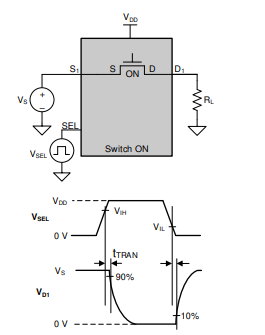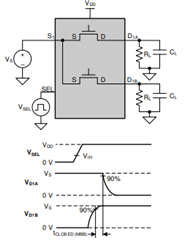TI switches and multiplexers datasheets often include a plethora of different timing characteristics that help define exactly how each device will behave transiently under a certain set of operating conditions. This FAQ will give details on the meaning of the following common timing characteristics and how they can impact your system:
- Transition Time (tTRAN)
- Device Turn-On/Turn-Off Time from Enable Pin (tON(EN) or toff(EN))
- Break-Before-Make Time (tBBM)
- Make-Before-Break Time (tMBB)
- Supply Turn-On Time (tON(VDD))
- Propagation Delay (tPD)
- Output-to-Output Skew (tSK)
Transition Time (tTRAN) - The time taken by the switch output to rise or fall within a given percentage of the final value after the address signal has risen or fallen past the logic threshold.

The Transition Time can be thought of as how long it takes for the output voltage to change given a change of logic input (either a transition from logic high to low or low to high). This parameter is usually tested by providing a fast logic transition to the logic pin, then monitoring the output voltage to see how quickly it will rise or fall to around 90%/10% of the maximum value.
Device Turn-On/Turn-Off Time from Enable Pin (tON(EN) or toff(EN)) - The time taken by the switch output to rise or fall within a given percentage of the final value after the enable has risen or fallen past the logic threshold.

Very similar to the Transition Time, Device Turn-On/Turn-Off Enable Time looks at how long it takes for the output voltage to change given a change in state of the Enable pin on a device.
Break-Before-Make Time (tBBM) - Ensures that in a multiplexer, two multiplexer paths are never electrically connected when the signal path is changed by the select input.

The Break-Before-Make time is a safety feature that makes certain that two channels are never connected at the same time. When a multiplexer or signal switch has this feature, during a switching event the switch will essentially be floating for the timing specified (tBBM) and will then connect to the designated channel. While most of TI’s multiplexer portfolio incorporates this feature, it is best to check the datasheet to ensure whether or not this is present in the device you are using.
Make-Before-Break Time (tMBB) - Ensures that in a multiplexer, two multiplexer paths are never electrically disconnected when the signal path is changed by the select input.

The Make-Before-Break is a feature that makes certain that there is never a discontinuity between the output being connected to an input. While this feature is not as commonly implemented in many of out multiplexers and signal switches, there are several devices in our portfolio that incorporate this feature that can be useful in several applications (example devices include the TS5A3160, TS5A3154, and TS5A23160).
For more information regarding tBBM or tMBB, please refer to our FAQ on the topic located here.
Supply Turn-On Time (tON(VDD)) - The time taken by the output of the device to rise to 90% after the supply has risen past the supply threshold. The 90% measurement is used to provide the timing of the device turning on in the system.

The Supply Turn-On Time is how long it takes for the output of the device to reach 90% after the supply voltage is applied to the device. An important note here is that it can be potentially damaging to place voltages on the other pins prior to the supply voltage being ramped. The inputs should either be ramped with the supply, ramped after the supply is present, or use a device has some overvoltage, fail safe logic, or powered off protection present to withstand these conditions.
Propagation Delay (tPD) - The time required for a signal to pass from the input signal pin to the respective output signal pin.

The Propagation Delay is essentially how long it takes for an input to pass or appear on the output of the multiplexer or signal switch. Often times, however, this parameter is heavily dictated by loading conditions and will be valid only for those conditions as specified on the datasheet. We also have a useful FAQ that goes over how to calculate the approximate propagation delay you can expect for your exact system.
Output-to-Output Skew (tSK) - The maximum difference between the propagation delays of different outputs due to different internal paths.

Skew in a signal switch or multiplexer refers to the difference in propagation delays that can exist between channels within the same device. While not given in some datasheets, the previously linked FAQ also goes into how this can be approximated using common datasheet parameters (such as using Delta RON which is the difference in resistance between adjacent channels).

